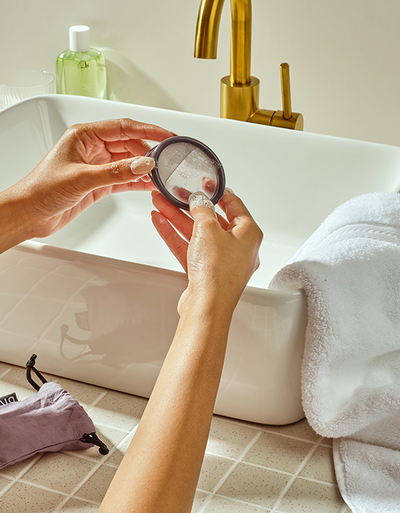
In this article /

We spoke to several of our Impact partners and asked them what needs to happen to propel the menstrual equity movement to its next stage in Canada.
Here’s what they had to say:
1. Education is central to achieving menstrual equity:
A 2023 survey by Plan International revealed that 62 percent of Canadian women did not receive any or adequate menstruation education. When we don’t talk about periods, and more specifically, the experiences of menstruation, we can’t advocate for menstrual equity. To intimately know and be comfortable with your own body, including the vulva and vagina, is to be empowered.
Tanaka Chitanda, Co-Executive Director of Hey Black Girl! advised that a lack of accessible menstrual education is far more widespread than expected. Menstruation, despite being a natural biological process, is still taboo in some Black communities. Menstruators often feel embarrassed to openly discuss menstruation and are made to feel the need to hide conversations.
Advocating for open, gender-inclusive conversations minimizes the stigma and taboo around menstruation. Gender-inclusive education includes inclusive language (i.e. menstruators) as well as making menstrual conversations open to non-menstruators.
2. Education must happen through a culturally relevant lens:
In 2024, with the support of MEF funding, Moon Time Connections (MTC) launched a free, 2-day Moon Time Facilitator training Program, training over 150 FNIM Moon Time Facilitators in 11 provinces/territories across the country.
Providing menstruation education through a culturally relevant lens helps to fill in gaps in menstrual education created by colonization, empowers folks with vital knowledge, and equips them with the tools to continue educating one another from within. The workshops also support the revitalization of Traditional Languages by ensuring resources are translated into as many languages as possible.
MTC was also funded via the MEF to host sewing circles in the north. MTC shipped sewing machines to communities in Bella Bella and Kangirsuk, where participants were taught how to sew cloth pads from scratch. The ability to sew reusable products has enormous potential to help alleviate the stress of the lack of menstrual product accessibility for northern menstruators, giving them more agency over their Moon Times.

Image Source: Monthly Dignity
In Quebec, Monthly Dignity saw the gap in access to youth-friendly French-language menstrual health resources and acted. They offer free community menstrual health workshops, in English and French, alongside their product donations to local schools, community organizations, and French linguistic minority communities across Canada. The workshops are tailored to children and adults alike, and tackle everything from menstrual health basics (including how to use menstrual cups and discs!), conversation starters, and tips on how to run effective and equitable menstrual product distribution programs.
3. Water justice and menstrual equity are linked:
Access to potable water and safe and inclusive bathrooms is critical for menstrual and vulvovaginal health. Research has shown that menstrual health inequities and limited access to WASH (Water, Sanitation, and Hygiene) facilities disproportionately affect individuals in remote Indigenous communities and those experiencing homelessness.
Water justice and menstrual equity are intimately connected. Without access to clean water both at home and in social settings, menstruators are not able to attend school or work. When environmental barriers exist, people are prevented from safely caring for their periods, and their dignity and sense of autonomy are restricted.
In response to these barriers, a team from the University of Manitoba and Moon Time Connections have joined together in the Just Waters project to raise awareness of water justice and menstrual equity in Canada.
4. Access to free period products must become universal:
The Period Purse researched the economic impact of period poverty in Canada and found that the cost of managing a period can range from $6.40 to $17.60 per cycle, adding up to nearly $6,000 over a lifetime. That’s a huge financial burden, especially considering a menstruator may use 20-22 disposable products during their period per month. Reusables like the Diva Cup, which costs $35 and can last for years and help alleviate the financial burden. However, access to reusable menstrual products also requires education, comfort, and proper facilities, which are up to our institutions to put in place to make this more accessible.
Organizations like Period Positive Workplace encourage workplaces to provide menstrual products for free in safe and inclusive bathrooms. In their research, they found that “8 out of 10 people who menstruate have started their periods unexpectedly while at the workplace. 96 percent of these people have had to leave their place of work to find menstrual products”. Likewise, the Canadian Public Health Association reports that “70% of menstruators have missed school or work because of their period”.
One incredible project, an interactive website, powered by the Period Pin, provides a map of Canadian locations offering free period products, often in inclusive bathrooms, increasing public access.
Additionally, several provinces across Canada, including Ontario, British Columbia, Manitoba, Newfoundland and Labrador, and Nova Scotia, have provided free period products in schools. By making period products free and accessible, people who menstruate gain agency to attend school and work. While not the only solution to menstrual equity, product access is a critical step towards long-term solutions.
5. Menstrual equity and reproductive healthcare are intimately linked:
Menstrual equity also includes access to safe, affordable, and timely healthcare. Medical racism and gender bias stall treatment, lead to misdiagnosis, and in the case of women’s health, dismiss the impact painful periods can have on someone’s life. Those with endometriosis, PCOS, and PMDD have increased needs not only for products, but also, medication, dietary, and mobility needs.
The Endometriosis Network of Canada reports that “9 in 10 young people who miss school due to endo symptoms do so because their periods are too painful, and 4 in 10 people with endometriosis have difficulty reaching their educational goals”. From an economic standpoint, “$2.5B is the estimated cost of endometriosis on the Canadian health care system per year, and 1 in 5 people with endometriosis have either lost or quit a job at some point during their life because of the disease.” Menstrual-related symptoms need to be taken seriously, no matter the gender or age of the patient.
Professors Lowik and Smith when looking at the menstrual equity movement in Canada, and political emphasis on access to products, note that “providing someone with free period products will not heal their untreated endometriosis, nor will it fill the profound gaps in knowledge about peri/menopause”. Access to reproductive healthcare and funding for women-centred medical research is an aspect of menstrual equity that is often overlooked.
Next Steps…
As a systemic issue, period poverty touches every aspect of a menstruator's life. From how they work, eat, live, learn, move in society, and practice self-care.
Chances are you are linked to one of the five areas above that contribute to menstrual inequity. Menstrual equity is a collective, societal mission.
Don’t hesitate, start today:
-
Advocate in your workplace and schools for paid menstrual leave and access to free products.
-
Sign petitions, and when possible, provide funding in support of community workshops and pilot projects.
-
Donate menstrual care products to your local food bank or schools.

